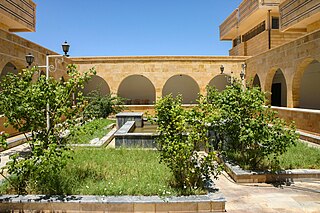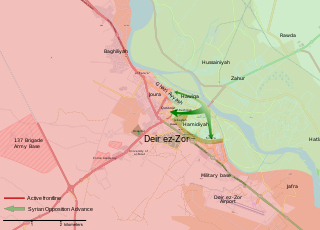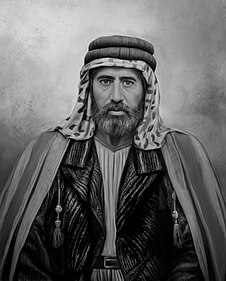
Deir ez-Zor is the largest city in eastern Syria and the seventh largest in the country. Located 450 km (280 mi) to the northeast of the capital Damascus on the banks of the Euphrates River, Deir ez-Zor is the capital of the Deir ez-Zor Governorate. In the 2018 census, it had a population of 271,800 people.

Deir ez-Zor Governorate is one of the fourteen governorates (provinces) of Syria. It is situated in eastern Syria, bordering Iraq. It has an area of 33,060 km2 and a population of 1,239,000. The capital is Deir ez-Zor. It is divided roughly equally from northwest to southeast by the Euphrates. Most of the territory on the river's left bank is part of the Autonomous Administration of North and East Syria, while that on the right bank is controlled by the Syrian government.

The Deir ez-Zor Camps were concentration camps in the heart of the Syrian desert in which many thousands of Armenian refugees were forced into death marches during the Armenian genocide. The United States vice-consul in Aleppo, Jesse B. Jackson, estimated that Armenian refugees, as far east as Deir ez-Zor and south of Damascus, numbered 150,000, all of whom were virtually destitute.
Taybeh also spelled Taibeh or Tayiba may also refer to:

The Deir ez-Zor Museum is a museum devoted to the archaeology and history of northeastern Syria, an area more commonly known as the Jezirah, or Upper Mesopotamia. The museum is located in Deir ez-Zor, the capital of Deir ez-Zor Governorate, Syria. It was founded in 1974 and housed in a gallery of a shopping mall. Between 1983 and 1996, it was located in an old law court built in 1930. In 1996, the museum moved to its current location in a building that had been especially designed for the museum. The exhibition halls cover an area of 1,600 square metres (17,000 sq ft) and are arranged around a courtyard. The construction of the new museum was a joint Syrian–German operation.

Protests against the Syrian government and violence had been ongoing in the Syrian city of Deir ez-Zor since March 2011, as part of the wider Syrian Civil War, but large-scale clashes started following a military operation in late July 2011 to secure the city of Deir ez-Zor. The rebels took over most of the province by late 2013, leaving only small pockets of government control around the city of Deir ez-Zor.
Al-Salihiyah is a town in eastern Syria, administratively part of the Deir ez-Zor Governorate, located on the western bank of the Euphrates River, south of Deir ez-Zor. Nearby localities include al-Asharah, Mayadin and al-Muhasan to the north and Hajin and al-Jalaa to the south. According to the Syria Central Bureau of Statistics, al-Salihiyah had a population of 4,471 in the 2004 census. The village is located just next to the site of ancient Dura-Europos.

Diban is a town in eastern Syria, administratively part of the Deir ez-Zor Governorate, located along the eastern bank of the Euphrates River, south of Deir ez-Zor, 17 kilometers south of al-Busayrah and 13 kilometers north of Al-Asharah. Nearby localities include Al Mayadin to the north and west, al-Hawayij to the northeast, Mahkan to the south west and al-Tayanah to the southeast. According to the Syria Central Bureau of Statistics, Diban had a population of 9,000 in the 2004 census. It is the administrative seat of a nahiyah ("subdistrict") which consists of ten localities with a total population of 65,079 in 2004.
The Deir ez-Zor offensive was executed by the Islamic State of Iraq and the Levant, also known as ISIS, against all other opposition forces in the Deir ez-Zor Governorate as part of the Inter-rebel conflict during the Syrian Civil War.

The Deir ez-Zor offensive (2016) was an ISIL military operation, during which it took over the northern suburbs of Deir ez-Zor on 16 January 2016, and killed from 135 to 300 people, while also kidnapping about 400 others.

The Syria's Tomorrow Movement is a Syrian opposition party founded in March 2016 in Cairo by Ahmad Jarba, a Syrian National Council member. The party is backed by Egypt and the United Arab Emirates and cooperates with the National Coalition for Syrian Revolutionary and Opposition Forces, although it is not part of the coalition. They also cooperate with the Syrian Democratic Council of the Autonomous Administration of North and East Syria.

The Deir ez-Zor offensive was a military operation launched by the Islamic State of Iraq and the Levant (ISIL) against the Syrian Armed Forces, to capture the city of Deir ez-Zor, on 14 January 2017. The offensive came amid the group losing large amounts of territory in the Raqqa offensive as well as the Turkish military intervention in Syria, while Iraqi forces were advancing in its Iraq headquarters in Mosul. It ended with the city being split into two parts.

The siege of Deir ez-Zor was a large-scale siege imposed by the Islamic State of Iraq and the Levant (ISIL) against several districts in the city of Deir ez-Zor held by the Syrian Army, in an attempt to capture the city and secure full control of the Deir ez-Zor Governorate. The ISIL siege of the city lasted for almost 3 years and 2 months, after which the Syrian Army launched a successful offensive that fully recaptured the city nine weeks later.
The following is a timeline of the Syrian Civil War from September to December 2017. Information about aggregated casualty counts is found at Casualties of the Syrian Civil War.
The 2017 Euphrates Crossing offensive was a military offensive launched by the Syrian Arab Army against members of the Islamic State of Iraq and the Levant (ISIL) in the Deir ez-Zor Governorate, following the breaking of the three-year siege of the city of Deir ez-Zor. The Euphrates Crossing offensive, conducted by government troops, was done with the aim of denying US-backed Syrian Democratic Forces and the US itself leverage over the Syrian government.

The Deir ez-Zor offensive was a military operation launched by the Syrian Armed Forces to completely expel the Islamic State of Iraq and the Levant (ISIL) from the city of Deir ez-Zor, a provincial capital, located on the banks of the Euphrates river. From 2014 until 2017, the city had been divided into Syrian government and ISIL-controlled halves. The rest of the Governorate (province) was under ISIL control for most of this time, putting the government-controlled half of the city under siege.

The Eastern Syria campaign of September–December 2017 was a large-scale military operation of the Syrian Army (SAA) and its allies against the Islamic State of Iraq and the Levant (ISIL) during the Syrian Civil War. Its goal was to clear the city of Deir ez-Zor of any remaining ISIL forces, capture ISIL's de facto capital of Mayadin, as well as seize the border town of Abu Kamal, which became one of ISIL's final urban strongholds by the latter stages of the campaign.
On 29 April 2018, clashes took place between Syrian government forces and the Syrian Democratic Forces (SDF) in Deir ez-Zor Governorate.

Ayyash Al-Haj Hussein Al-Jassim, a Syrian leader from Deir al-Zour city, began the armed struggle against the French colonizer in governorate of Deir al-Zour in 1925 coinciding with the outbreak of the Great Syrian Revolution in Jabal al-Arab and Ghouta of Damascus. He was sentenced by the French to exile to Jableh city with his family after they were convicted of planning and carrying out several military operations against the French forces, the latest was in "Ain Albu Gomaa". They also sentenced his eldest son Mohammed 20 years in prison on the island of Arwad, and executed his son Mahmoud by shooting with a number of other revolutionaries.












